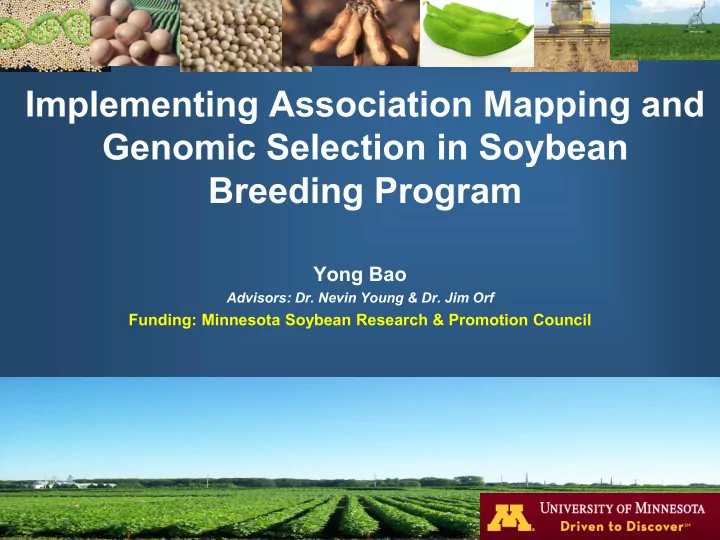

Implementing Association Mapping and Genomic Selection in Soybean Breeding Program Yong Bao Advisors: Dr. Nevin Young & Dr. Jim Orf Funding: Minnesota Soybean Research & Promotion Council
Outline • Overview of all on-going projects • Introduction of association mapping (AM) and genomic selection (GS) • Association mapping for PI88788 derived soybean cyst nematode (SCN) resistance • Prediction accuracy of GS for quantitative resistance to SCN • Conclusion and perspectives
Overview Oil Protein Yield SCN SDS Bao, Y. , T. Vuong , C. Meinhardt , R. Denny, P. BSR Tiffin, S. Chen, H. Nguyen , J. H. Orf, and N. D. Young (2014): “Potential of Association Dr. Jim Kurle, UMN Mapping and Genomic Selection to Explore PI88788 Derived Soybean Cyst Nematode Resistance .” The Plant Genome DOI:10.3835/plantgenome2013.11.0039.
Outline • Overview • Introduction of association mapping (AM) and genomic selection (GS) • Association mapping for PI88788 derived soybean cyst nematode resistance • Prediction accuracy of GS for quantitative resistance to SCN • Conclusion and perspectives
Genome-wide Association Mapping • Allele mining for quantitative traits in diverse germplasm collection including advanced breeding lines, cultivars, landraces, etc. • Potentially high mapping resolution with high-density markers • Constraint: the existence of subpopulations may cause false positives
Genomic Selection: An improved marker-base selection without QTL mapping Training Training Genotyping & Genotyping & Population Population Phenotyping Phenotyping GEBV: Genomic Estimated Breeding Value Breeding Breeding Calculate Calculate Make Make Genotyping Genotyping Material Material GEBV GEBV Selections Selections Heffner, Sorrells & Jannink. Crop Science 49:1-12
i th line y = m 1 n + X i g i + e Training Population Marker matrix SNP marker effect ... ... Chr n Chr 1 Chr 2 Chr 3 + 40 + 20 SNP Known SNPs effect - 00 - 20 Sum of all marker effects p G EBV X i g Breeding Material i i 1 SNP marker effect Marker matrix 1 + 1 - 1 - 1 + 1 + 25 - 1 + 1 - 1 - 1 - 1 + 42 + 1 - 1 - 1 - 1 - 1 - 22 - 1 + 1 - 1 - 1 = +38
Outline • Overview • Introduction of association mapping (AM) and genomic gelection (GS) • Association mapping for PI88788 derived soybean cyst nematode resistance • Prediction accuracy of GS for quantitative resistance to SCN • Conclusion and perspectives
Sources of resistance of 1,500 commercial SCN-resistant soybean cultivars rhg1 Shier, M. 2009. http://web.extension.uiuc.edu/livingston/reports/i281/index.html
Select 282 Germplasm Based on Footprints Mandarin Ottawa Harosoy Harrow Corsoy Strain 171 Capital Hodgson Harrow Lincoln M10 Richland M53-117 PI180501 Hodgson B.C. Mukden M76-151 Blackhawk Richland Merit Strain 171 Capital Harrow M70-271 Mandarin Lincoln Manchu Traverse M64-3 Mandarin Ottawa PI196163 Footprint value : Lincoln > Capital > Traverse
Phenotyping and Genotyping + SCN race 3 (HG type 0) 1,536 genome-wide Two replications of five SNPs Goldengate plants for each genotype Assay ( Hyten et al., ( Guo et al., 2005, U of 2010 ) Missouri ) Minor allele frequency > 5% Missing rate < 50% Number of female nematodes on a given individual Hutcheson FI 100 Mean number of female nematodes on
Three Groups Exist in Panel
Three Loci Identified in AM rhg1 FGAM1 FGAM1 rhg1 Novel FDR = .05 Novel
LD Plot for rgh1 and FGAM1 Regions 300kb rhg1 Satt309 ~ 1.1 Mb FGAM1 LD: r 2 = ~ 0.8
Outline • Overview • Introduction of association mapping (AM) and genomic selection (GS) • Association mapping for PI88788 derived soybean cyst nematode resistance • Prediction accuracy of GS for quantitative resistance to SCN • Conclusion and perspectives
Six-fold Cross-validation • Each subset: 282/6 = 47 lines • Training set: 47*5 = 235 lines • Test set: 47 lines • Prediction accuracy = correlation of GEBV and phenotypic value in test set
GS is significantly more accurate than MAS & All GS prediction algorithms are equivalent
Account for Major QTL in GS y = m 1 n + Wm + X i g i + e RRF-BLUP Model SNPs to be fixed FGAM1 rhg1 Novel
Compare GS w/o Major QTL Fixed 0.8 GS with major QTL fixed 0.7 Correlation 0.6 GS without major QTL fixed 0.5 RRF RR 0.4 96 192 288 384 768 1152 Number of SNP markers
Conclusion and Perspective • AM detected significant signals at rhg1 and FGAM1 , plus the third locus located on chromosome 18. • GS was more accurate than marker-assisted selection (MAS) strategies using two significant markers alone. • AM was extended to SDS, and GS was extended to yield, protein, and oil for MN germplasm.
Acknowledgements C ommittee Soybean Pathology Lab • Dr. Nevin Young (co-advisor) • Grace Anderson • Dr. James Orf (co-advisor) • Colin Zumwalde • John Lencowski • Dr. Rex Bernardo • Erin Walch • Dr. Senyu Chen • Adam Barbeau • Dr. James Kurle • Dante Leyva • Marissa Scherven • Dr. Peter Tiffin Graduate Students Collaborators • Ahmad Sallam • Dr. Henry Nguyen, Dr. Tri Voung, and • Landon Ries Clinton Meinhardt University of Missouri • JoAnn Kirsch • Ben Campbell Genomics and Bioinformatics Lab • Lian Lian • Amy Jacobson • Roxanne Denny • Kevin Silverstein Funding • Surabhi Mithal • Peng Zhou • Joseph Guhlin • Diana Trujillo • Shaun Curtin Soybean Breeding Group • Gerald Decker • Darcy Weston • Phil Schaus • Rafael Echenique • Leo Moros • MAST Students
Recommend
More recommend